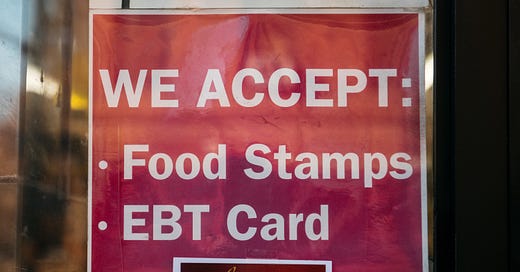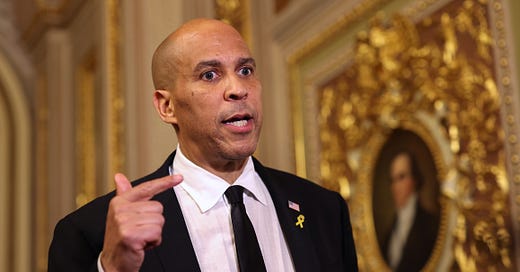
Food Stamps and the 2020 Election
Trump’s cuts to SNAP benefits will likely hurt him in states crucial to his re-election chances.

Two weeks ago, when the Trump administration announced that it was going to implement new rules restricting full access to food-stamp benefits for about 3.7 million Americans, commentators were quick to resort to the usual clichés. A Los Angeles Times editorial dubbed Trump “President Scrooge” and, referring to affected families with children, said: “Too bad for all those Tiny Tims out there.” Meanwhile, the conservative website Legal Insurrection found a way to blame the previous president: “Under Obama, being on food stamps was portrayed as ‘cool’ and even something to aspire to. After all, one could get lobster and a host of other luxury food items via the Supplemental Nutrition Assistance Program (SNAP).”
Looking beyond these reflexive responses, the substantive arguments for and against this change to the food-stamps program are pretty straightforward. The number of individuals using food stamps doubled between 1990 and 2010, from about 20 million to 40 million. The number of people receiving benefits peaked at 48 million in 2013. In part, the increase was due to the opening up of the program in response to the Great Recession. The figure has since come back down every year, and is now at or likely under 40 million.
In explaining the rationale for raising the bar for SNAP accessibility, the Trump administration points to today’s low unemployment levels. Analysts who support the move seem to believe that the time is overdue for policy to get back to encouraging the old “work-and-save” Protestant ethic, and that having food stamps too readily available is more of a hindrance than a help in achieving self-sufficiency. And the new regulations are expected to save taxpayers some $5.5 billion over five years.
Meanwhile, policy analysts who oppose the change argue that it will especially harm people in places where the jobs outlook isn’t as rosy as the national average.
These are both respectable arguments—and both can be understood in the context of our nation’s decades-long dispute over welfare, social security, and entitlements.
But for present purposes, I want to consider not the wisdom of the change to the food-stamps program but its political ramifications. Specifically, what might result from having this change hit the fan in April, about six months before voters go to the polls in the 2020 presidential election?
The numbers hold little good news for President Trump. The policy change could make it much more difficult for him to win re-election in some swing states he barely won in 2016. It is the old problem he can’t seem to shake: Cutting food-stamp spending might play to the base on the right that he already securely has, but will likely alienate the independent voters in the up-for-grabs swing states he really needs.
The political problem arises not just from the changed circumstances of the Americans who will no longer be receiving food stamps, but also from the economic consequences. The change will “lead to substantial economic dislocations which [will] permeate the entire country,” according to Ray Perryman, head of an economics research institute based in Waco, Texas. The Perryman Group estimates that “the costs to the U.S. economy would include $37.7 billion in total expenditures and $18.1 billion in gross product each year as well as the loss of more than 189,000 jobs on an ongoing basis (including multiplier effects).”
The reason for all this is very simple: People use their SNAP benefits to buy food—food often produced in the United States—and they buy it mostly at stores owned and operated by Americans. To put it in dollar figures, think of it this way: About 354,000 Florida residents will lose their SNAP benefits if the Trump administration makes its planned changes, and that means that some $650 million of government food money won’t be spent in local, privately owned Sunshine State stores.
It is unclear why Trump is willing to accept the potential political costs of this change at this point in the election cycle. It would have been more politically prudent to do it at the beginning of his current term or at the beginning of the next one if he retains the presidency. Half a year before the election may be the worst of times.
As we sort this out, it is quite apparent that the tightening up of SNAP qualifications for able-bodied adults, making them meet specific work requirements—and making it more difficult for people to qualify for the roughly $125 a month in food benefits in counties with low unemployment levels—can hurt Trump with voters in the states he really needs:
Pennsylvania: 20 electoral votes, 289,000 people likely affected by the change to SNAP benefits
Michigan: 16 EVs, 178,000 people likely affected
Wisconsin: 10 EVs, 105,000 people likely affected
Florida: 29 EVs, 354,000 people likely affected
Nevada: 6 EVs, 77,000 people likely affected
Minnesota: 10 EVs, 46,000 people likely affected
Arizona: 11 EVs, 72,000 people likely affected
Georgia: 16 EVs, 89,000 people likely affected
North Carolina: 15 EVs, 96,000 people likely affected
Whomever the Democrats nominate as their presidential candidate will need to flip only about 40 electoral votes from 2016, and that could be done with just Michigan and Florida. That’s how close it is.
One of the reasons these states matter is that Trump is below the water line in approval in all of them but Florida (his approval rating is slightly up in the latest polls there). Consider this: In Michigan, Pennsylvania, and Wisconsin, Trump won 46 electoral votes by a combined total of 77,000 votes. In those three states alone, the number of people expected to lose some or all of their SNAP benefits in April will be about 572,000.
Do the Democrats have enough smarts to figure out how to take advantage of this situation? They would have to station someone outside the government offices where SNAP benefits are administered, register them to vote, and then make sure they do. Sounds easy, but Hillary Clinton’s campaign had a hard time filling requests for yard signs in Michigan and took in roughly 50,000 fewer votes in Detroit than Obama did in 2012. Trump won the state by 11,000.
Earlier this year, I wrote about seven counties in those three states—three counties each in Pennsylvania and Wisconsin, and one in Michigan—that voted for Trump in 2016 and Obama in 2012. If those three counties were to flip back in 2020 to how they voted in 2012, Trump would lose all three states and the presidency. In those seven counties, about 48,000 people will be affected by the new food-stamps regulation. That is about 62 percent of the total number of votes by which Trump won the three states.
In Florida, Trump won by 113,000 votes, and 354,000 people will be affected by the change in the food-stamps regulation. Again, in a close race one can see how valuable those 354,000 people could be.
If all that seems to stack the deck against Trump, let’s take a closer look at the money that these states’ stores can expect to have disrupted come April. Calculating from figures provided by USDA and the Urban Institute, here is roughly how much each of these states in political play will lose in annual government-funded food spending:
Pennsylvania: $420 million
Michigan: $260 million
Georgia: $140 million
Wisconsin: $130 Million
Arizona: $100 million
Florida: $650 million
Ohio: $130 million
Minnesota: $60 million
Nevada: $110 million
North Carolina: $160 million
One more problem for Trump in this matter is how the poverty that SNAP addresses is no longer just in the central cities. As Brookings Institution scholar Elizabeth Kneebone explained,
Between 2000 and 2015, the poor population in smaller metropolitan areas grew at double the pace of the urban and rural poor populations, outstripped only by poverty’s growth in the nation’s suburbs. Suburbs in the country’s largest metro areas saw the number of residents living below the poverty line grow by 57 percent between 2000 and 2015. All together, suburbs accounted for nearly half (48 percent) of the total national increase in the poor population over that time period.
That is to say, the suburbs—so essential to Trump’s 2016 victory—are increasingly likely to be home to more recipients of SNAP benefits than ten years ago.
Taking all these data points together, this policy change looks like trouble for Trump: The SNAP pullback will hit Midwest swing states very hard—states that he needs to win, and states that have still not fully recovered from the Great Recession. It will hit suburbs hard, too, which Trump needs to win.
And what might President Trump gain politically from this policy change? His supporters will claim that surveys show that voters, especially Republicans, are against “handouts” like food stamps. They are, but not in the way you might think. Yes, Republicans might think that poor people in New York, Los Angeles, or Chicago sometimes abuse the system and need to be cut off. But they don’t think that what happens in those Democrat strongholds also happens in their neighborhoods.
So a 2016 Trump voter in, say, Macomb County outside of Detroit, when picturing a typical food-stamp user probably no longer thinks only of the people living in the poverty-ridden Chandler Park neighborhood off Interstate 94 in Detroit, but also of some of those guys he used to work with who live in one-story, single-family homes off East 8 Mile Road in Warren. Those guys aren’t moochers; they just need a little more time to get things sorted out.
In other words, as voters always say, “The problem isn’t here, it’s over there.” Poverty and all of its adjacent problems tend to be like that.
From a political point of view, it’s not difficult to understand: Take care of the big and controversial social and cultural problems when you are not running. Because if you trot out serious changes during the election year, those cultural issues can turn into a voter problems.









